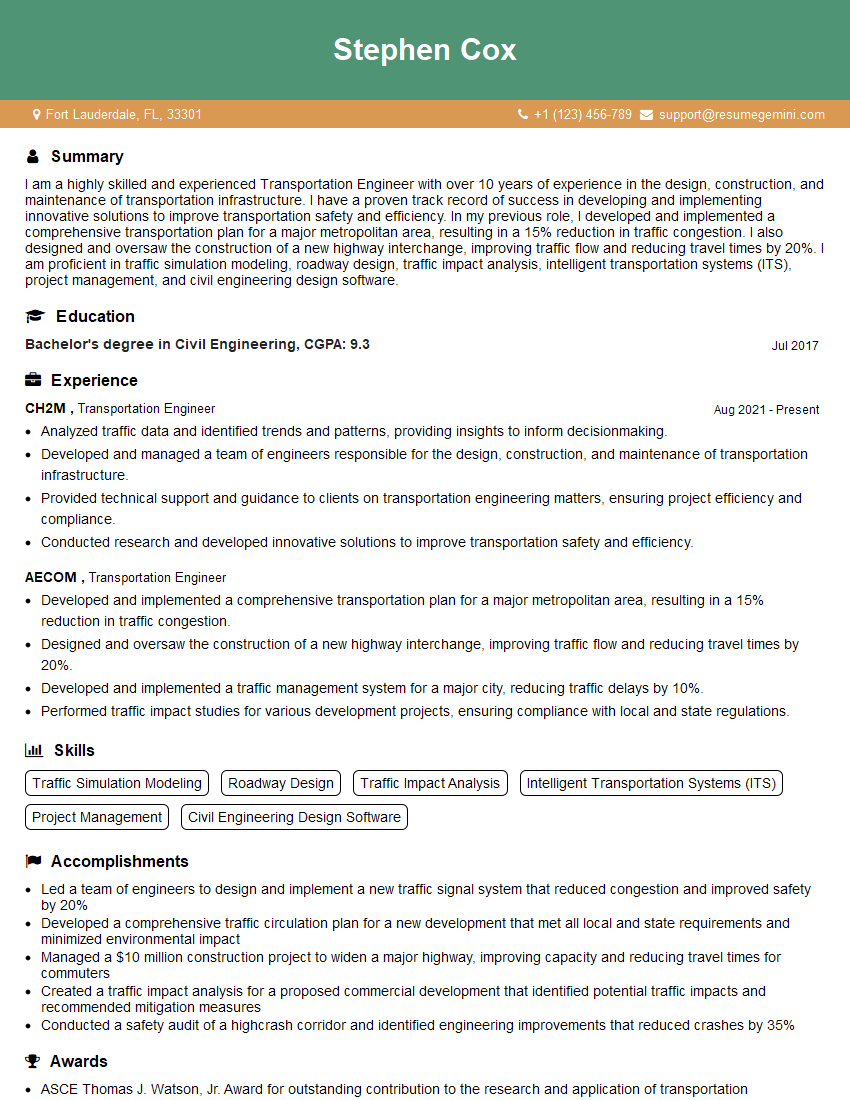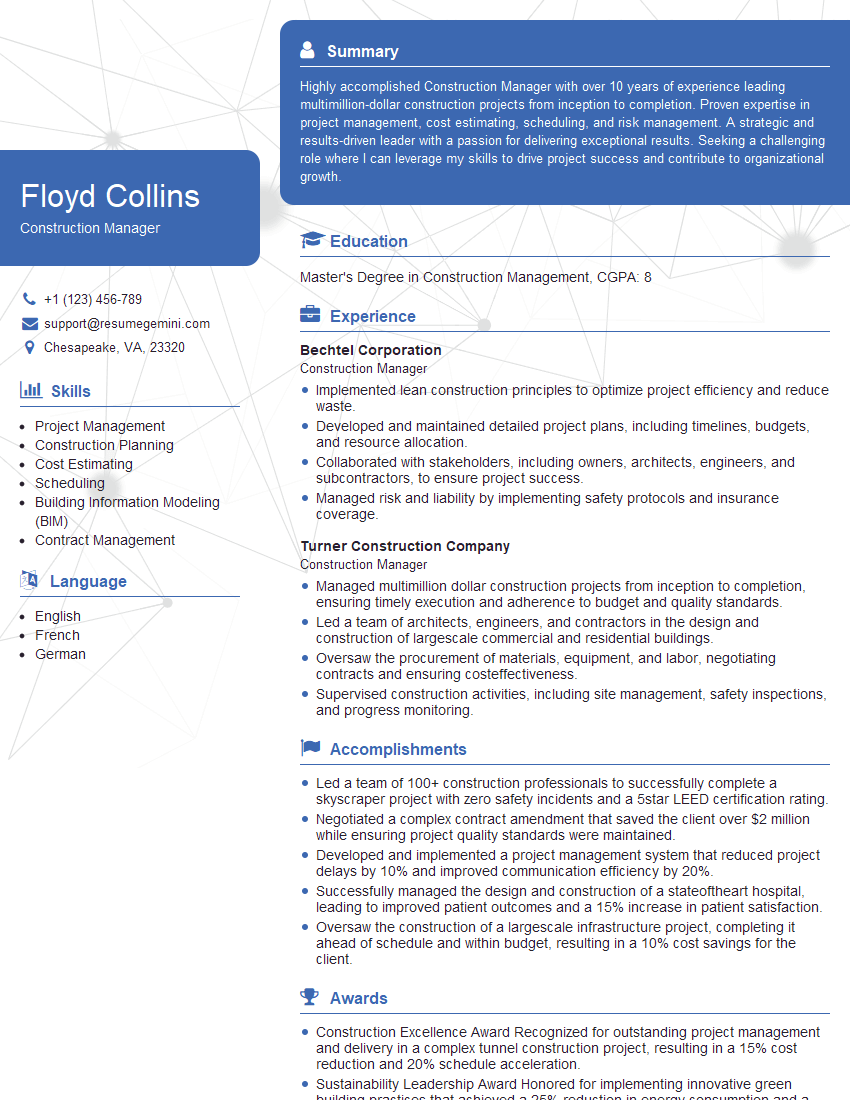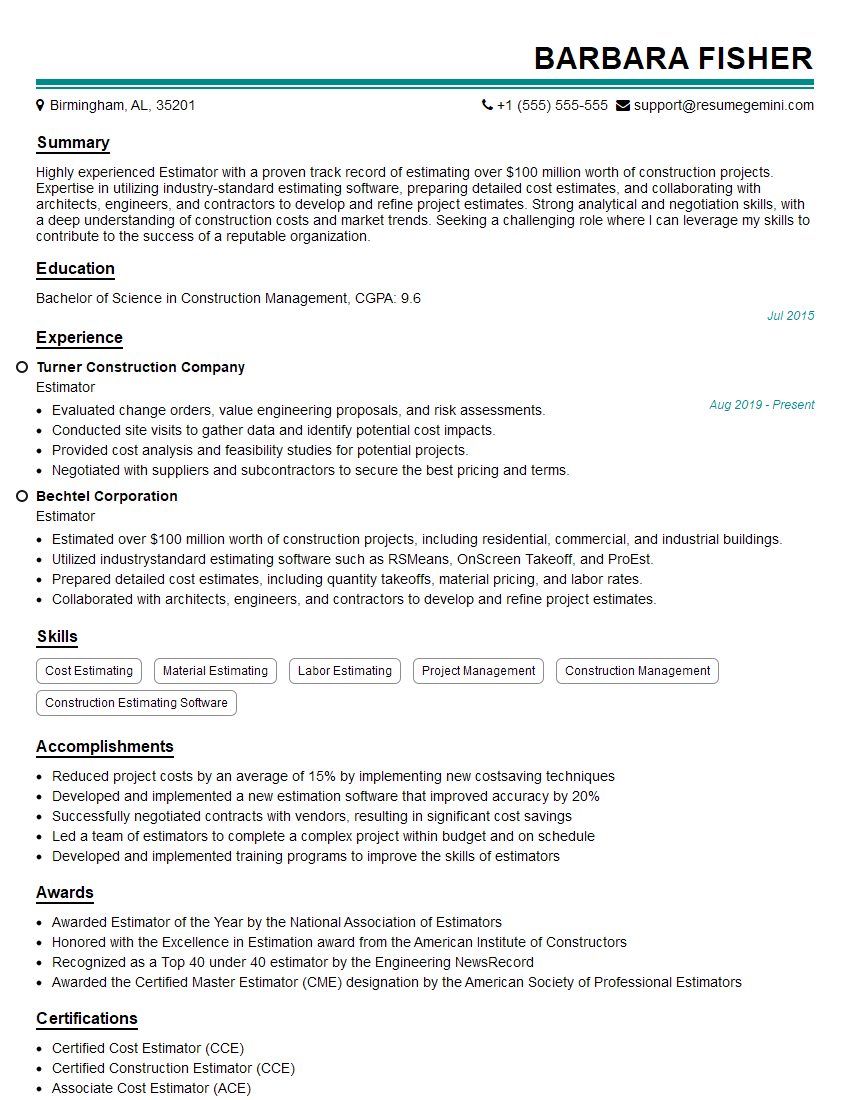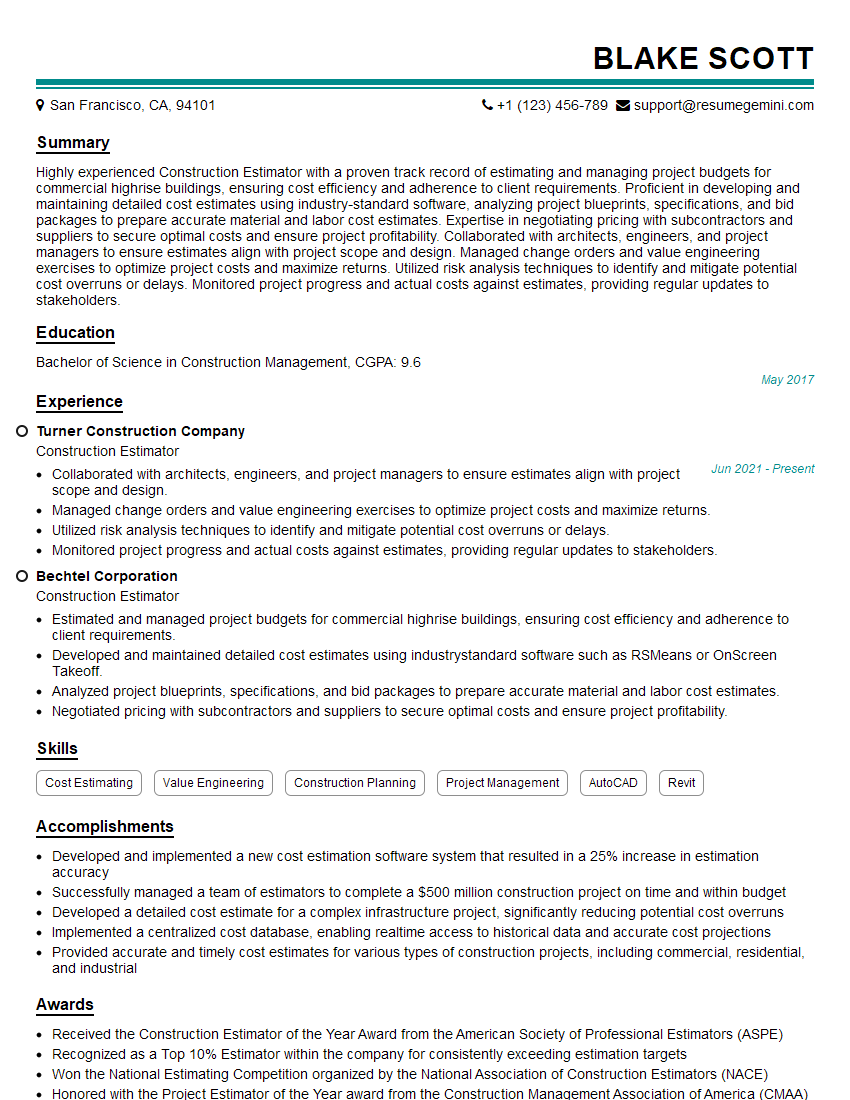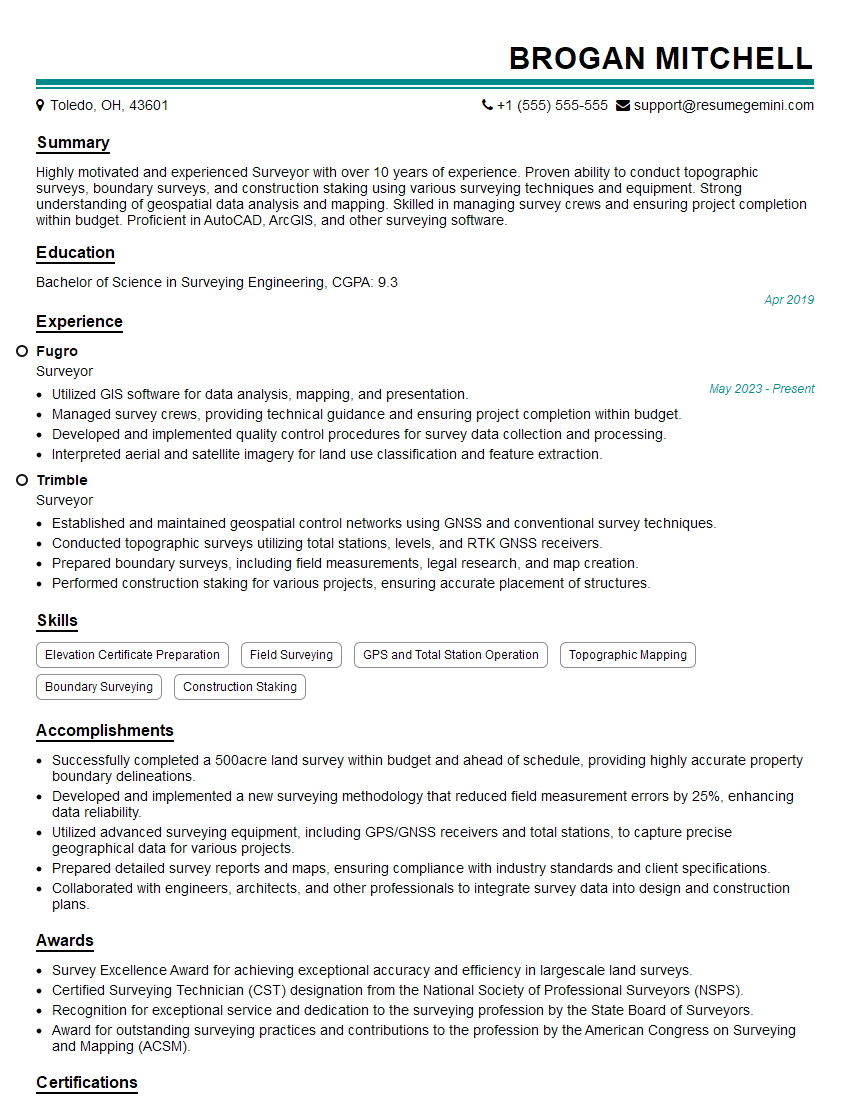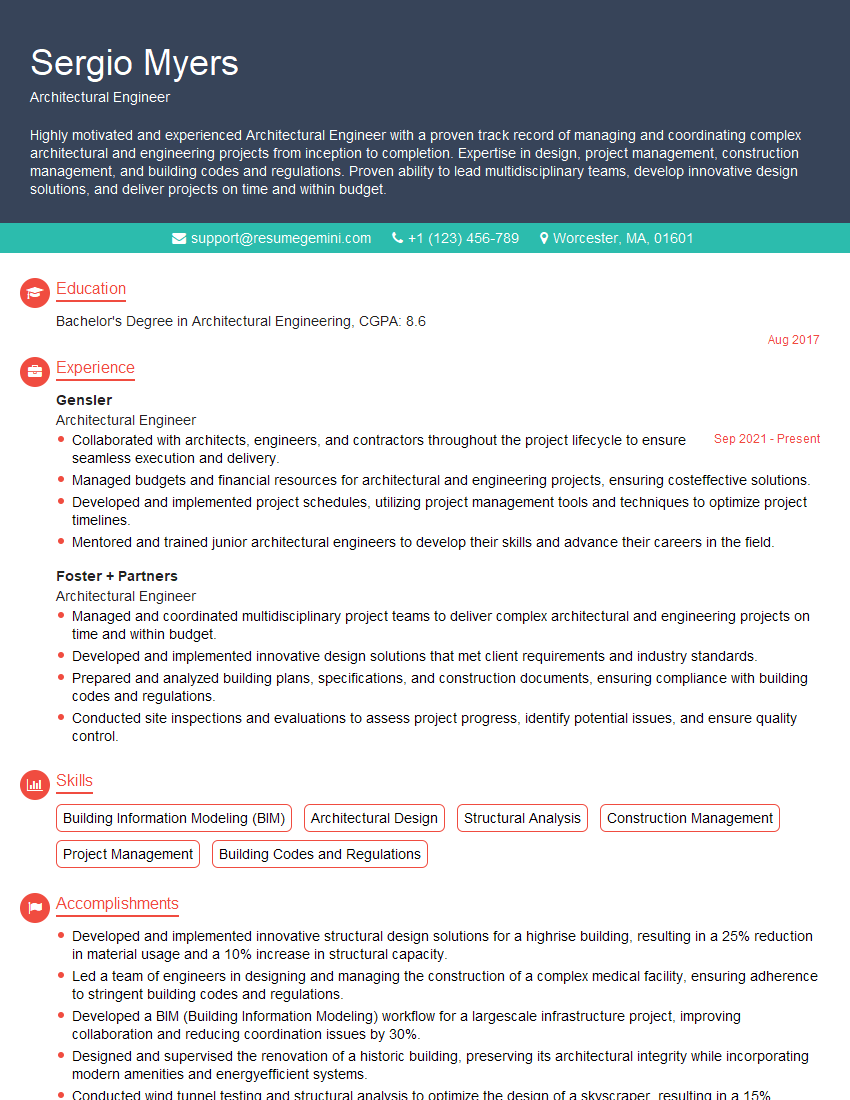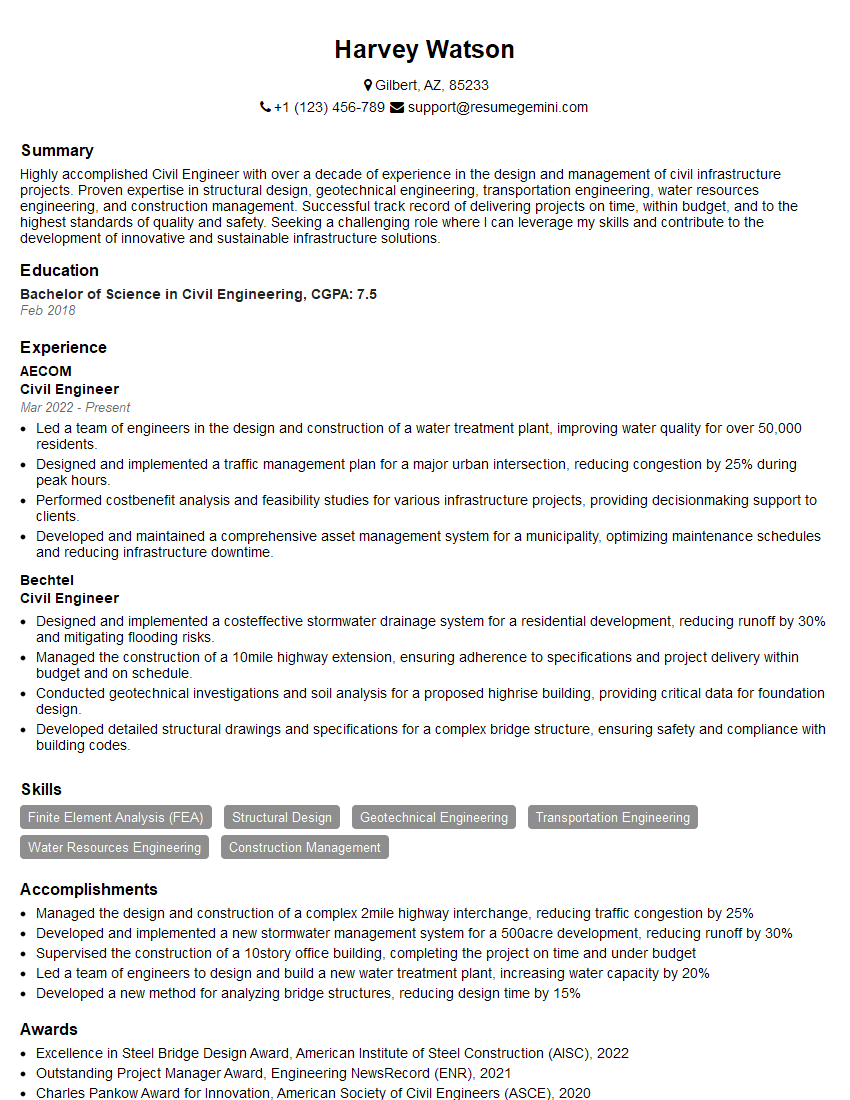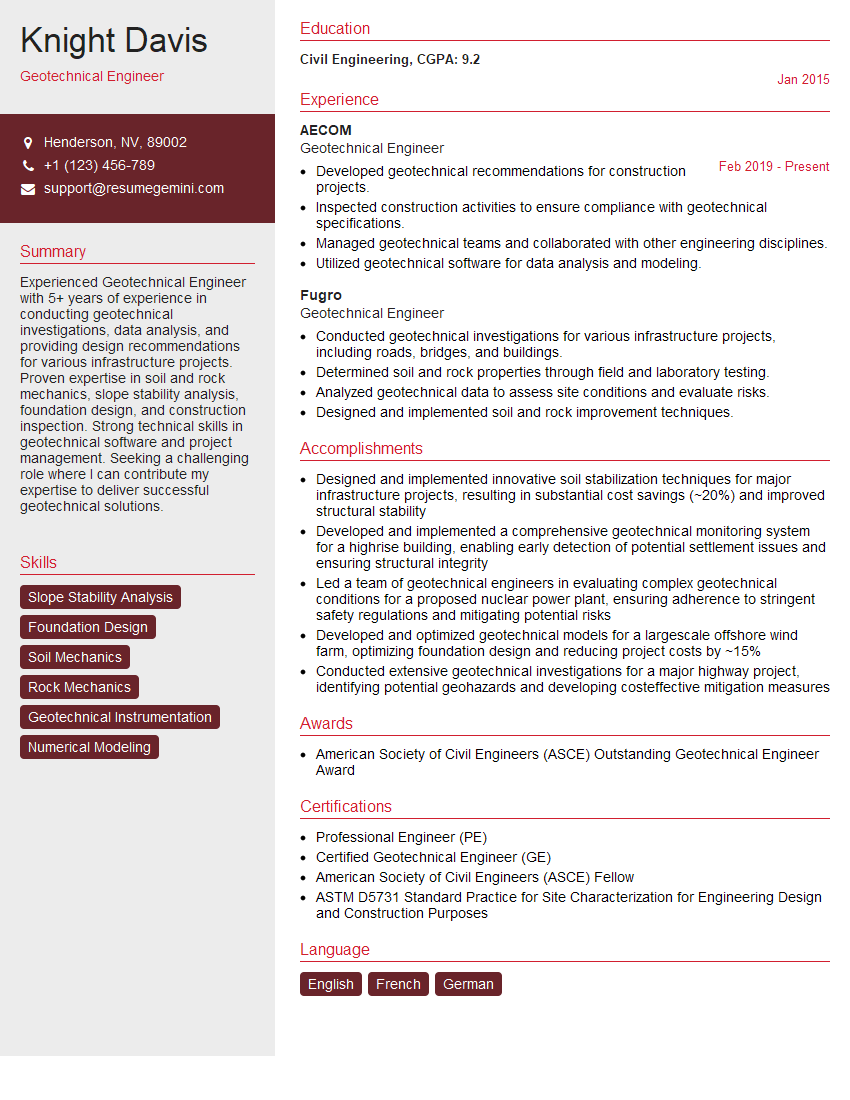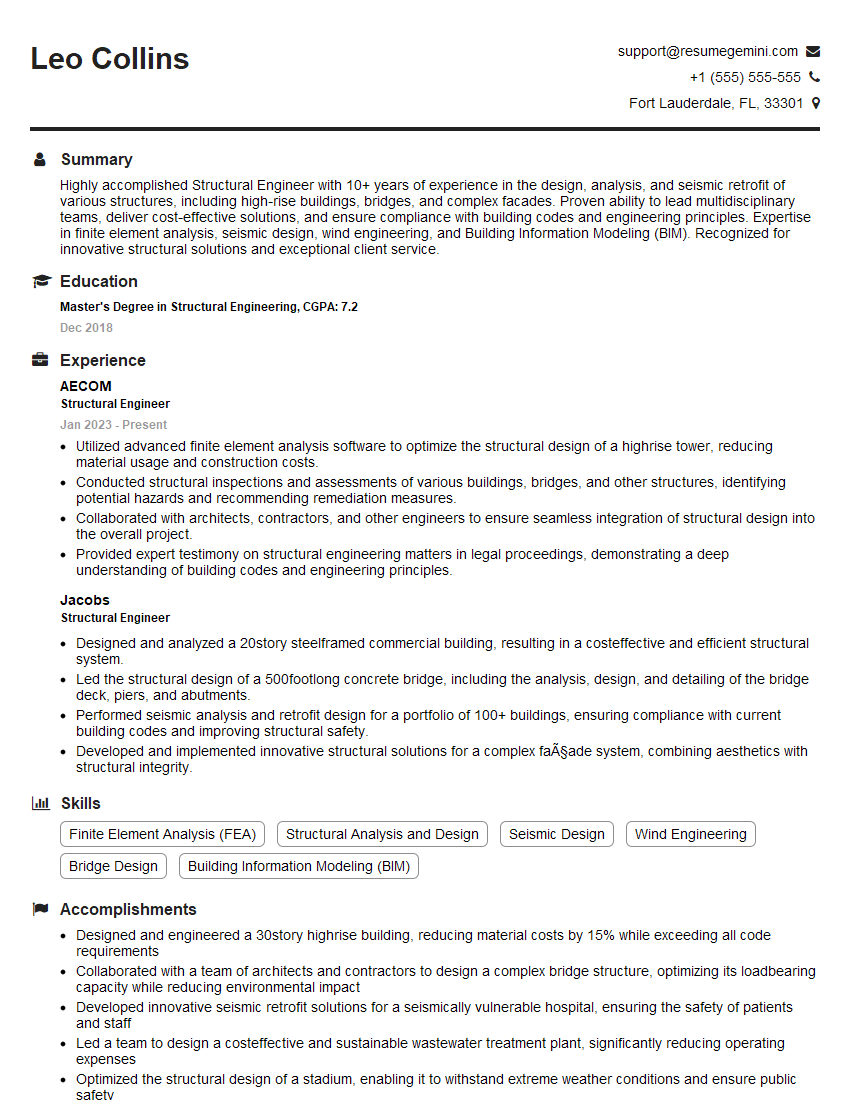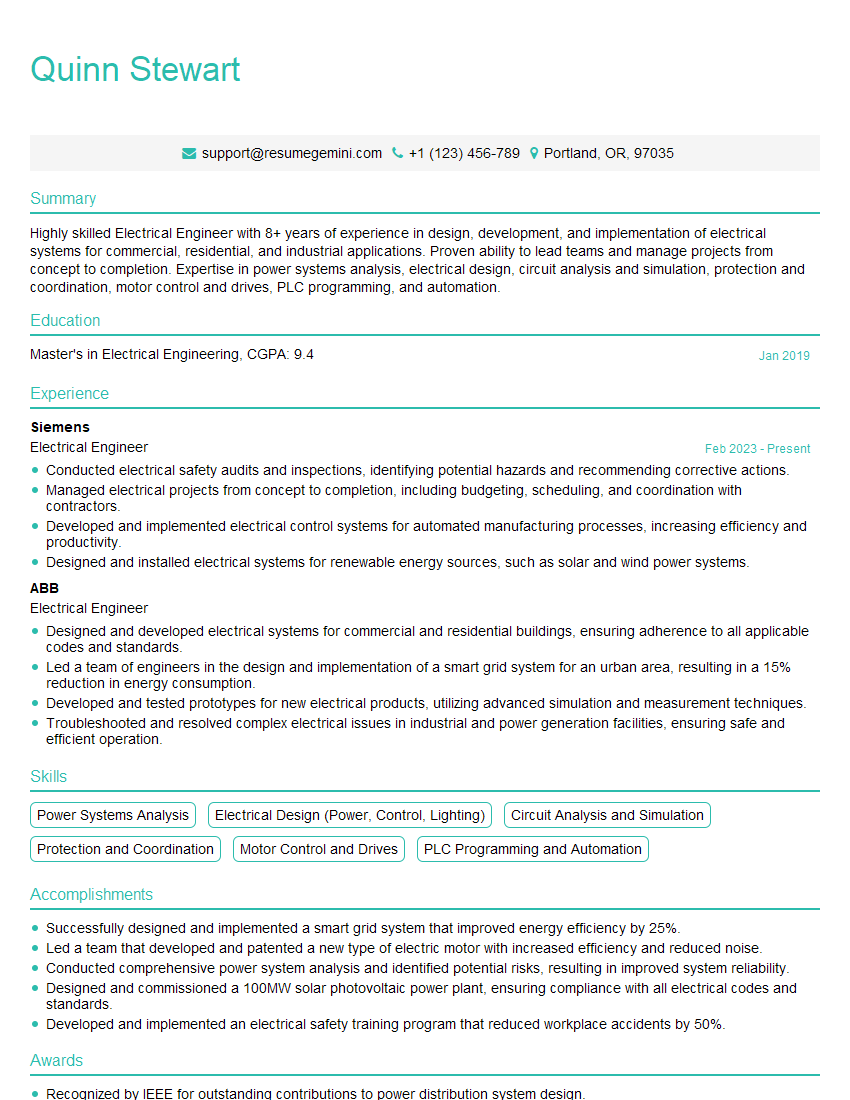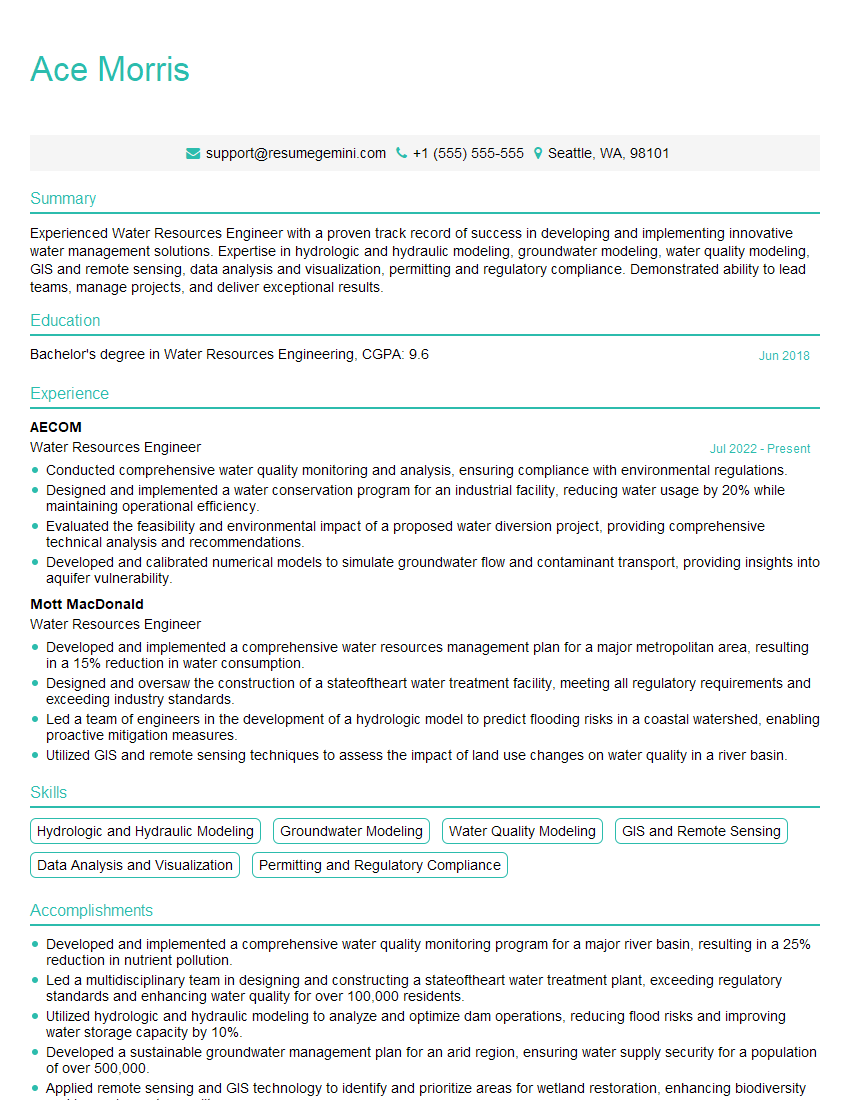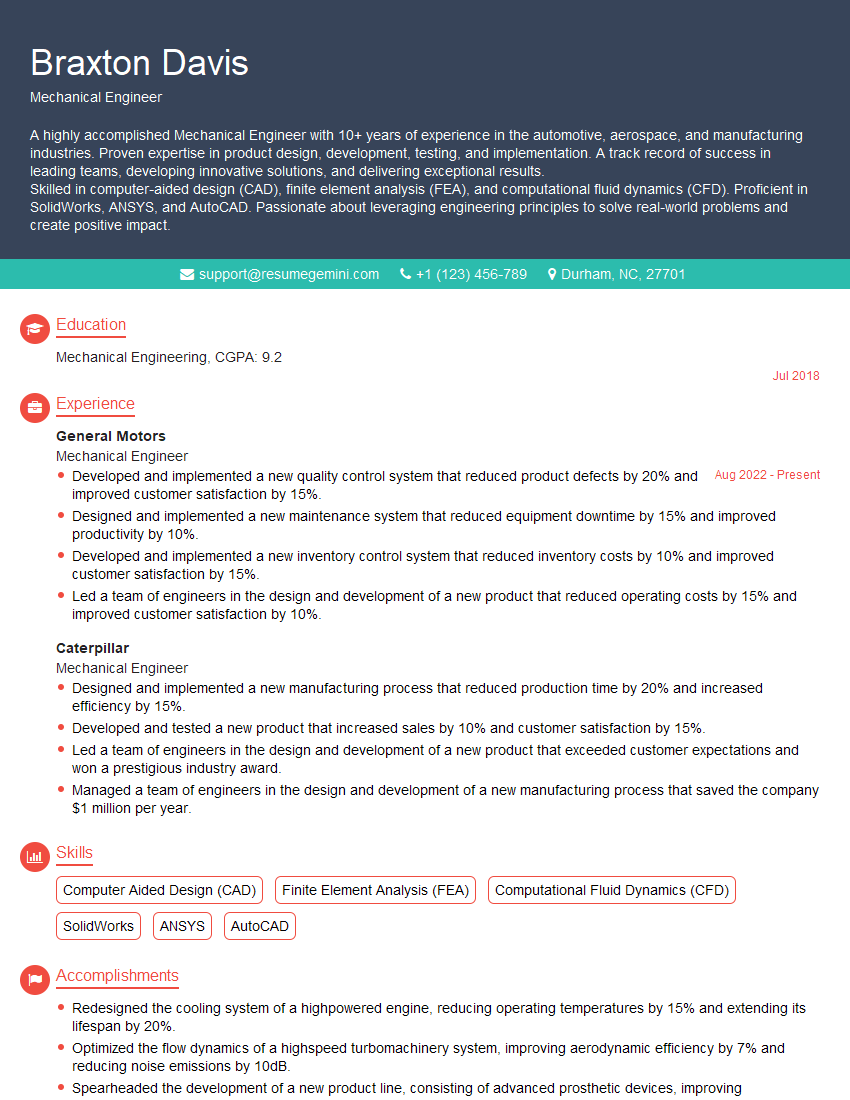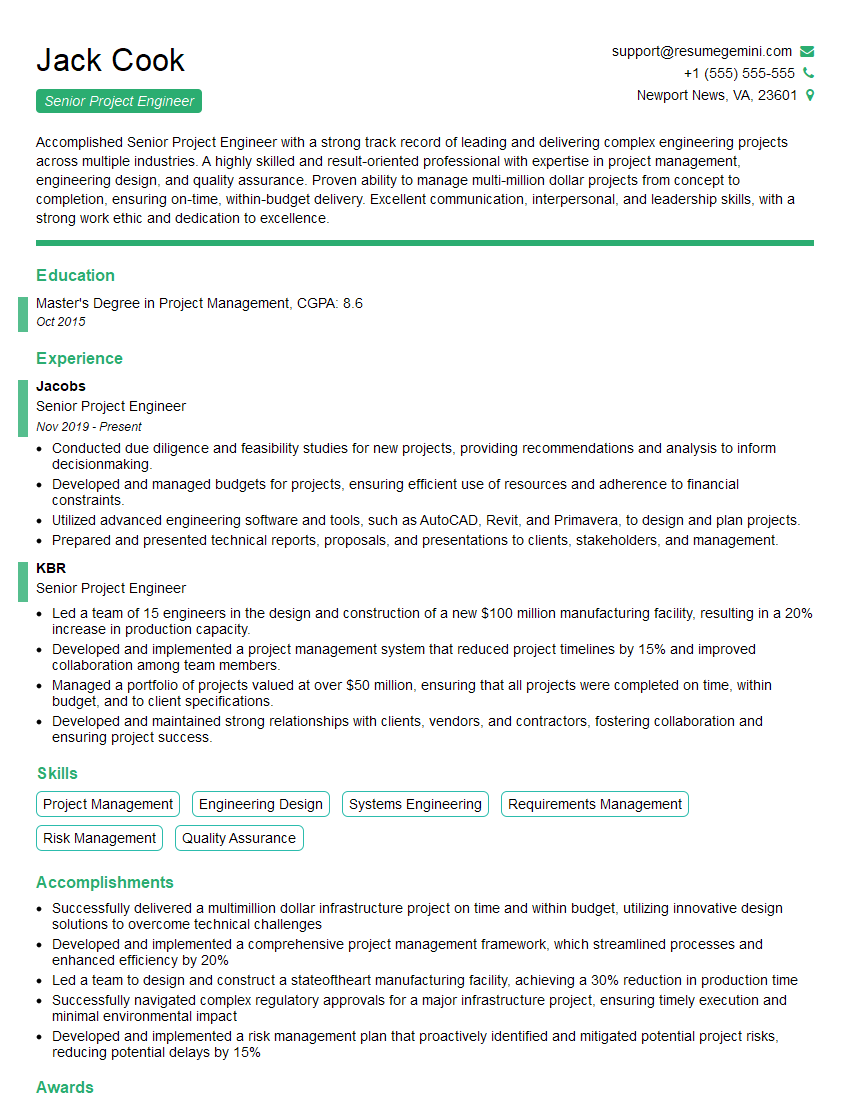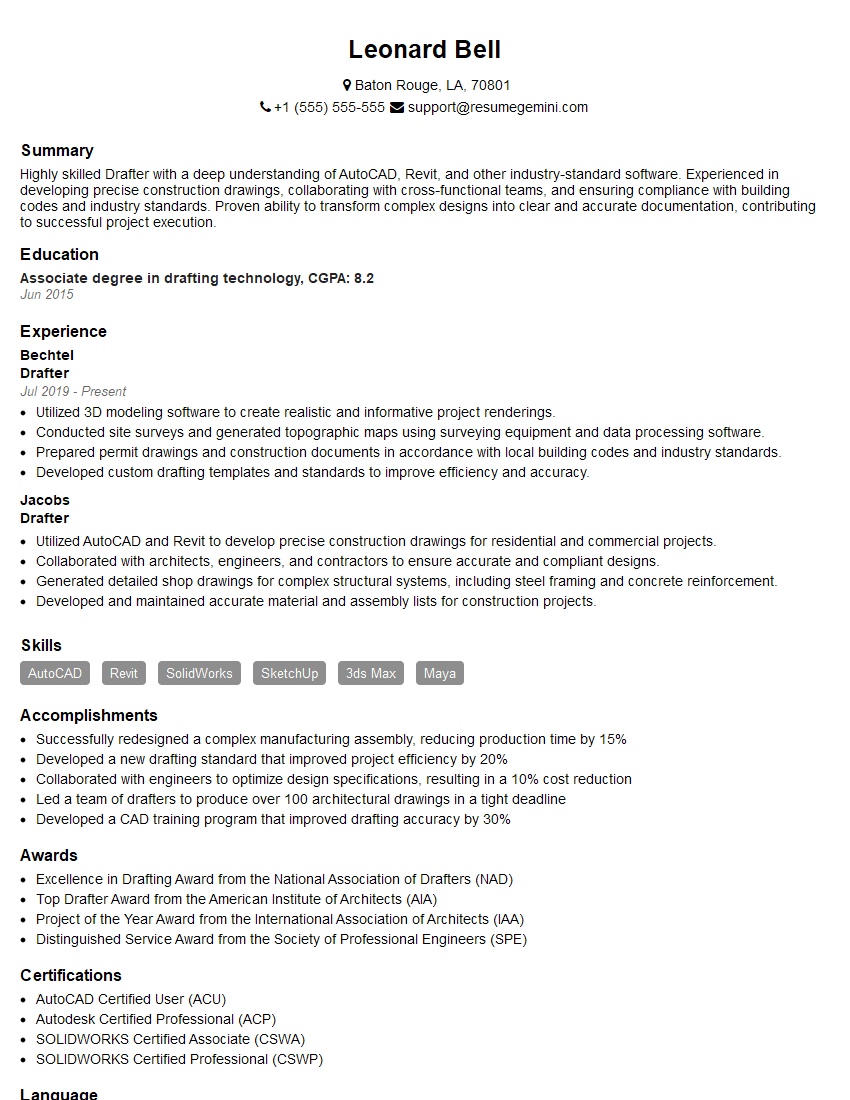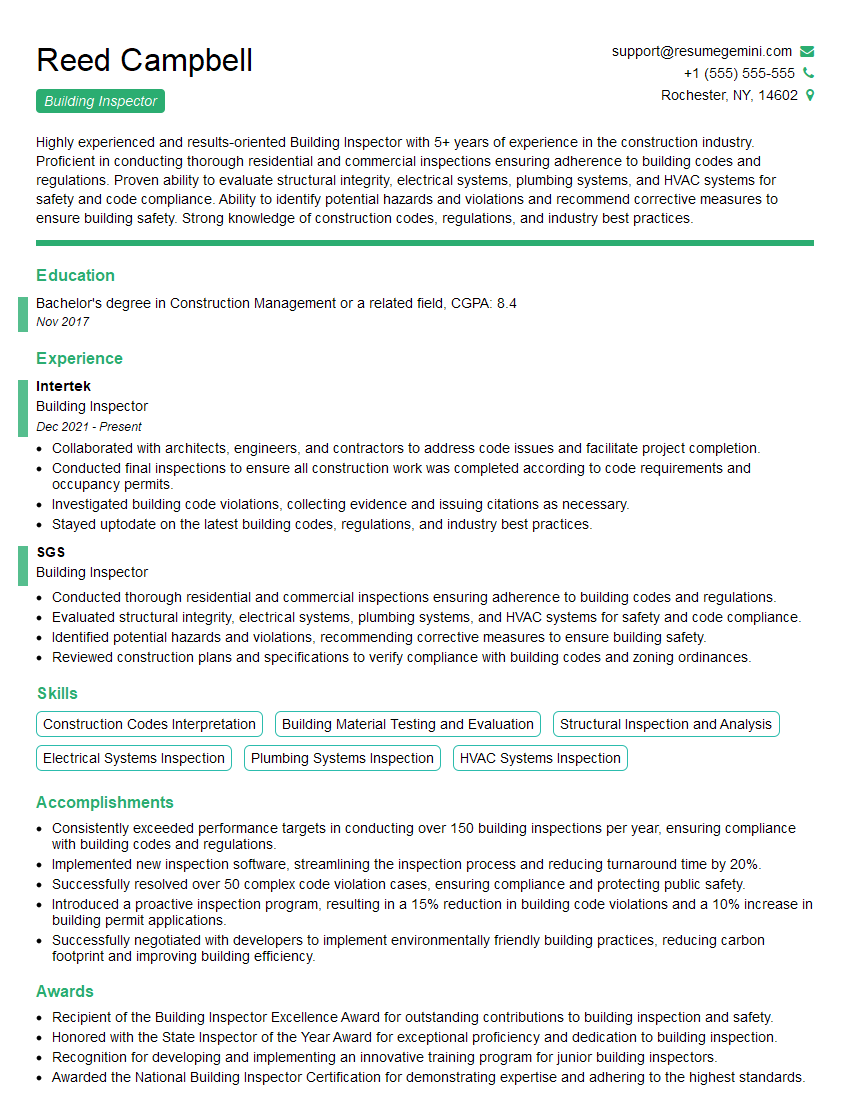Preparation is the key to success in any interview. In this post, we’ll explore crucial Construction and Engineering Practices interview questions and equip you with strategies to craft impactful answers. Whether you’re a beginner or a pro, these tips will elevate your preparation.
Questions Asked in Construction and Engineering Practices Interview
Q 1. Describe your experience with different types of construction contracts (e.g., lump sum, cost-plus).
Construction contracts are the legal agreements that define the responsibilities and obligations of all parties involved in a construction project. I have extensive experience with various contract types, including lump sum, cost-plus, and design-build.
- Lump Sum Contracts: In a lump sum contract, the contractor provides a fixed price for the entire project scope. This is ideal for projects with well-defined plans and specifications, minimizing cost uncertainty for the client. However, it requires thorough upfront planning and can penalize the contractor for unforeseen changes or issues. For example, I worked on a school renovation project using a lump sum contract. We meticulously detailed the scope, ensuring a clear understanding with the client to avoid disputes.
- Cost-Plus Contracts: Cost-plus contracts reimburse the contractor for actual costs incurred, plus a predetermined fee or percentage. This is more suitable for complex projects with evolving designs or uncertain conditions. The client bears more cost risk, but the contractor has more flexibility. I utilized a cost-plus contract for a large-scale infrastructure project where unforeseen ground conditions required significant adjustments to the original plan. The transparency ensured by this contract type fostered trust and effective communication with the client.
- Design-Build Contracts: A design-build contract combines design and construction under a single entity. This streamlines the process, potentially accelerating project completion and improving communication. However, it requires a high level of trust and careful selection of the design-build firm. I’ve been involved in several design-build projects for commercial buildings, where the streamlined approach significantly reduced project timelines and minimized potential conflicts between design and construction teams.
Q 2. Explain your understanding of project scheduling and critical path method (CPM).
Project scheduling is crucial for effective project management. It involves creating a timeline that outlines the sequence of activities and their durations. The Critical Path Method (CPM) is a widely used technique to identify the longest sequence of activities (the critical path) that determine the shortest possible project duration.
Understanding the CPM allows for efficient resource allocation and identification of potential delays. Any delay on the critical path directly impacts the overall project completion date. For instance, in a recent high-rise construction project, we utilized CPM scheduling software to visualize the critical path. This allowed us to proactively manage resource allocation to activities on the critical path, preventing delays and keeping the project on schedule. The software also provided detailed reporting on the impact of potential delays on various tasks, helping us make informed decisions about mitigation strategies.
In simple terms, imagine building a LEGO castle. Some steps, like assembling the main tower, are crucial and must be completed before other parts can be added. These are the critical path activities. Delays in these steps delay the entire project.
Q 3. How do you manage risks and uncertainties in construction projects?
Risk management in construction is crucial for project success. We use a proactive approach, identifying potential risks early on and developing mitigation strategies. This involves:
- Risk Identification: Brainstorming sessions with the project team, reviewing historical data, and analyzing project plans to identify potential problems such as weather delays, material shortages, or labor disputes.
- Risk Assessment: Evaluating the likelihood and potential impact of each identified risk. We use a risk matrix to prioritize risks based on their severity.
- Risk Mitigation: Developing strategies to reduce the likelihood or impact of identified risks. This might include procuring materials early, securing alternative labor sources, or incorporating contingency plans for weather delays.
- Risk Monitoring and Control: Regularly monitoring the project for emerging risks and adapting mitigation strategies as needed.
For example, on a recent highway construction project, we identified the risk of severe weather delays during the winter months. Our mitigation strategy involved accelerating work during favorable weather conditions and having backup plans for critical activities that could be performed indoors or in sheltered areas. This proactive approach prevented significant project delays and cost overruns.
Q 4. Describe your experience with construction cost estimating and budgeting.
Construction cost estimating is the process of predicting the cost of a project. It’s a crucial step in determining project feasibility and securing funding. I have experience with various estimating methods, including:
- Unit-price estimating: This method involves estimating the cost of each unit of work (e.g., cost per square foot of concrete). It’s suitable for projects with well-defined quantities.
- Detailed estimating: This method involves breaking down the project into individual components and estimating the cost of each component. It provides a more accurate estimate but is more time-consuming.
- Parametric estimating: This method uses statistical models to estimate costs based on historical data and project parameters. It’s useful for preliminary cost estimation.
Budgeting involves allocating funds to different aspects of the project. We develop detailed budgets that align with the estimated costs. We use budgeting software and track expenses regularly to ensure the project stays within budget. On a recent commercial building project, detailed cost estimation enabled us to secure the necessary funding and effectively manage expenses throughout the project lifecycle.
Q 5. What are your preferred methods for quality control and assurance on a construction site?
Quality control and assurance are paramount in construction. My approach combines preventative measures and ongoing checks.
- Preventative Measures: This includes using high-quality materials, employing skilled labor, and implementing rigorous quality management systems from the design phase. Regular inspections and quality audits are conducted to ensure adherence to specifications and standards.
- Ongoing Checks: Daily inspections are performed by site supervisors to identify and correct defects early. We conduct regular quality control tests on materials and workmanship. Independent third-party inspections are also used to verify quality.
- Documentation: Thorough documentation of all quality control activities, including inspection reports, test results, and non-conformance reports, is essential for traceability and accountability.
For example, on a recent hospital construction project, our rigorous quality control measures ensured that all materials and workmanship met the stringent requirements for a healthcare facility. This prevented costly rework and ensured the safety and well-being of patients and staff.
Q 6. How do you ensure safety compliance on a construction project?
Safety is the top priority on any construction site. I enforce a comprehensive safety program that includes:
- Safety Training: All workers receive thorough training on safety procedures and the use of personal protective equipment (PPE).
- Site Safety Inspections: Regular inspections are conducted to identify and address potential hazards. This includes inspections of equipment, scaffolding, and work areas.
- Emergency Preparedness: We have detailed emergency response plans and conduct regular drills to ensure everyone knows how to respond to various emergencies.
- Safety Meetings: Regular safety meetings are held with workers to discuss safety concerns and best practices.
- Compliance with Regulations: We strictly adhere to all relevant safety regulations and standards.
Maintaining a safe work environment is not just a legal requirement; it’s a moral obligation. Proactive safety management prevents accidents, saves lives, and improves productivity.
Q 7. Explain your experience with building information modeling (BIM).
Building Information Modeling (BIM) is a digital representation of physical and functional characteristics of a place. I have extensive experience using BIM software to improve design, construction, and operations.
- Design Coordination: BIM facilitates better design coordination by allowing different disciplines (structural, MEP, architectural) to work on the same model, reducing clashes and errors.
- Construction Planning and Scheduling: BIM assists in creating 4D models (incorporating time) for better scheduling and sequencing of construction activities.
- Cost Estimation and Budgeting: BIM facilitates more accurate cost estimation by providing detailed quantities and material takeoffs.
- Facility Management: BIM creates a digital twin that can be used for facility management and maintenance.
For instance, on a recent large-scale hospital project, using BIM allowed us to identify and resolve design clashes before construction began, significantly reducing construction time and cost. The 4D model helped optimize construction sequencing, allowing us to better allocate resources and reduce project duration.
Q 8. Describe your experience with different types of construction materials and their applications.
My experience encompasses a wide range of construction materials, each with unique properties and applications. Understanding these properties is crucial for successful project execution.
- Concrete: A ubiquitous material, its strength and versatility make it ideal for foundations, structural elements, and pavements. I’ve worked extensively with various concrete mixes, from high-strength concrete for high-rise buildings to lightweight concrete for reducing structural loads. For example, on a recent project, we used a specialized high-performance concrete with a rapid setting time to minimize disruption during a bridge repair.
- Steel: Known for its tensile strength, steel is essential in structural frameworks, reinforcing bars (rebar) in concrete, and prefabricated components. My experience includes working with different steel grades, selecting appropriate ones based on structural requirements and considering factors like corrosion resistance. A project involving a large-span steel structure required detailed calculations and analysis to ensure structural integrity under various load conditions.
- Timber: A sustainable and aesthetically pleasing material, timber finds applications in framing, roofing, and decking. I have experience with various timber types and treatments, understanding their strengths and weaknesses in different environmental conditions. For example, I specified pressure-treated timber for a boardwalk project near the coast to protect it from decay.
- Masonry: Bricks, blocks, and stones offer durability and aesthetic appeal. My work includes specifying appropriate masonry units based on load-bearing requirements and aesthetic considerations, along with ensuring proper mortar selection and installation techniques. A recent restoration project involved careful selection of historically accurate brick types to maintain the building’s character.
Selecting the right material involves considering factors such as cost, durability, strength, aesthetics, sustainability, and local regulations. I always strive to optimize material selection for both performance and cost-effectiveness.
Q 9. How do you handle conflicts and disagreements among project stakeholders?
Conflict resolution is a critical skill in construction management. I approach such situations with a collaborative, problem-solving mindset, prioritizing open communication and mutual respect.
- Active Listening: I begin by actively listening to each stakeholder’s perspective, understanding their concerns and underlying interests. This ensures everyone feels heard and valued.
- Facilitation: I act as a facilitator, guiding stakeholders toward a common understanding. I encourage open dialogue and help identify areas of agreement and disagreement.
- Collaborative Problem-Solving: We work together to brainstorm solutions that address everyone’s concerns. This might involve compromise, negotiation, or finding creative alternatives.
- Documentation: Any agreements reached are meticulously documented and communicated to all stakeholders to avoid future misunderstandings.
- Escalation: If internal resolution fails, I escalate the issue to higher management, providing a clear summary of the situation and proposed solutions.
For instance, I once mediated a dispute between the contractor and the subcontractor regarding payment schedules. By facilitating open communication and clarifying contractual obligations, we reached a mutually agreeable solution, preventing project delays and maintaining positive working relationships.
Q 10. What is your experience with change orders and how do you manage them?
Change orders are inevitable in construction projects, often stemming from design modifications, unforeseen site conditions, or client requests. Effective change order management is crucial for maintaining project control and minimizing cost overruns.
- Formal Process: I strictly adhere to a formal process for managing change orders. This involves a written request outlining the changes, their impact on the schedule and budget, and a proposed revised schedule and budget.
- Impact Assessment: A thorough impact assessment is conducted to analyze the ramifications of the proposed changes. This includes evaluating the impact on the project schedule, budget, resources, and quality.
- Negotiation & Agreement: The change order is reviewed and negotiated with all relevant stakeholders, aiming to reach a mutually acceptable agreement on the revised cost and timeline.
- Documentation & Approval: Once agreed upon, the change order is formally documented, signed, and approved by all parties. This document serves as a legally binding agreement.
- Tracking & Monitoring: The implementation of the change order is closely tracked and monitored to ensure it stays on schedule and within budget.
For example, on a recent project, a change order was required due to the discovery of unexpected underground utilities. We followed our established process, documented the changes, negotiated a fair price adjustment, and implemented the changes with minimal disruption to the project timeline.
Q 11. Explain your understanding of geotechnical engineering principles.
Geotechnical engineering principles are fundamental to ensuring the stability and safety of any construction project. It involves understanding the soil and rock properties at a site to design appropriate foundations and earthworks.
- Soil Classification: This involves identifying the type of soil present (e.g., clay, sand, gravel) and its properties (e.g., strength, permeability, compressibility). Different soil types exhibit different behaviours under load.
- Site Investigation: This may involve drilling boreholes, conducting laboratory testing, and in-situ testing (e.g., cone penetration test, standard penetration test) to assess soil conditions accurately.
- Slope Stability Analysis: This is critical for cut and fill operations to prevent landslides or failures. Analysis considers soil properties, geometry of the slope, and groundwater levels.
- Foundation Design: Geotechnical data is crucial in designing suitable foundations (shallow or deep). The design should ensure sufficient bearing capacity to support the structure’s loads without settlement or failure.
- Groundwater Management: Understanding groundwater flow and pressure is vital for foundation design and earthworks to mitigate potential problems like seepage or heave.
Ignoring geotechnical considerations can lead to significant problems like foundation settlement, slope instability, and even structural collapse. A thorough geotechnical investigation and design are critical for safe and successful construction.
Q 12. Describe your experience with soil mechanics and foundation design.
My experience in soil mechanics and foundation design is extensive. I understand the behavior of soil under various loading conditions and can apply this knowledge to design stable and cost-effective foundations.
- Soil Testing and Analysis: I’m proficient in interpreting soil test data to determine key parameters such as shear strength, compressibility, and permeability. This data is crucial for foundation design.
- Foundation Type Selection: Based on soil conditions and structural loads, I select appropriate foundation types such as shallow foundations (spread footings, rafts, strip footings) or deep foundations (piles, caissons, piers). For example, in areas with weak soil, deep foundations are necessary to transfer loads to stronger soil strata.
- Settlement Analysis: I perform settlement analyses to predict the amount of settlement the foundation will experience under the imposed loads. This is vital to ensure the structure remains functional and aesthetically pleasing.
- Bearing Capacity Calculations: I determine the ultimate bearing capacity of the soil to ensure the foundation can safely support the structural loads. Safety factors are applied to account for uncertainties in soil properties.
- Ground Improvement Techniques: Where necessary, I incorporate ground improvement techniques like compaction, soil stabilization, or deep mixing to enhance soil properties and improve foundation performance.
One project involved designing deep foundations for a high-rise building in an area with soft clay. Through careful soil investigation and analysis, we designed a pile foundation system that ensured the building’s stability and minimized settlement.
Q 13. How do you manage construction projects within budget and schedule constraints?
Managing construction projects within budget and schedule constraints requires proactive planning, rigorous monitoring, and efficient problem-solving.
- Detailed Budgeting: I develop comprehensive budgets that accurately estimate all costs, including materials, labor, equipment, and contingencies. Regular cost tracking is essential to identify and address cost overruns early.
- Scheduling & Sequencing: I create detailed project schedules using critical path method (CPM) or similar techniques. This allows us to identify critical activities and potential delays, enabling proactive mitigation strategies.
- Resource Allocation: Efficient resource allocation is vital for timely project completion. This involves optimizing the use of labor, equipment, and materials.
- Risk Management: I identify potential risks and develop mitigation plans to minimize their impact on the budget and schedule. Regular risk assessment meetings are crucial.
- Progress Monitoring & Reporting: I implement rigorous progress monitoring systems, including regular progress meetings and reports to stakeholders. This ensures any deviations from the plan are promptly identified and addressed.
On a recent project, we encountered delays due to unexpected weather conditions. By using the project schedule and re-allocating resources, we successfully mitigated the impact on the overall project timeline, completing it within the revised schedule and budget.
Q 14. What are your preferred methods for communication and collaboration on a project team?
Effective communication and collaboration are paramount for successful project delivery. My preferred methods prioritize clarity, transparency, and efficient information flow.
- Regular Meetings: I hold regular meetings with the project team, including daily stand-up meetings for updates and weekly progress meetings for in-depth discussions.
- Project Management Software: We utilize project management software (e.g., Microsoft Project, Primavera P6) for task assignment, progress tracking, and document sharing. This facilitates clear communication and accountability.
- Digital Communication Tools: Email, instant messaging (e.g., Slack, Microsoft Teams), and video conferencing are used for quick communication and updates. This ensures efficient communication across geographical locations.
- Open and Transparent Communication: I foster a culture of open communication where everyone feels comfortable raising concerns or sharing information. Transparency prevents misunderstandings and improves team cohesion.
- Formal Documentation: All important decisions, agreements, and changes are meticulously documented to avoid ambiguities and disputes.
This multi-faceted approach ensures everyone is informed, engaged, and working towards common goals. For example, using a project management software during a large renovation project ensured all stakeholders were always aware of the latest progress, potential roadblocks, and upcoming tasks.
Q 15. Describe your experience with sustainable construction practices.
Sustainable construction practices are crucial for minimizing the environmental impact of the built environment. My experience encompasses various aspects, from material selection to waste management and energy efficiency.
- Material Selection: I prioritize using recycled and locally sourced materials to reduce embodied carbon. For example, on a recent project, we substituted traditional concrete with a lower-carbon alternative incorporating recycled aggregates, significantly reducing the project’s carbon footprint.
- Energy Efficiency: I’m experienced in designing buildings that incorporate passive solar design principles, high-performance insulation, and energy-efficient HVAC systems. In one instance, we integrated a geothermal heating and cooling system, resulting in a 40% reduction in energy consumption compared to a conventionally designed building.
- Waste Management: I implement rigorous waste management plans on every project, aiming for maximum recycling and diversion from landfills. This includes pre-construction planning to identify potential waste streams and establishing efficient on-site sorting and recycling systems.
- Water Conservation: I incorporate water-efficient fixtures and landscaping strategies to minimize water usage. For instance, we utilized rainwater harvesting systems and drought-tolerant plants on a recent residential project, significantly reducing the reliance on municipal water.
My commitment to sustainability extends beyond just material choices; it involves a holistic approach that considers the entire lifecycle of the building.
Career Expert Tips:
- Ace those interviews! Prepare effectively by reviewing the Top 50 Most Common Interview Questions on ResumeGemini.
- Navigate your job search with confidence! Explore a wide range of Career Tips on ResumeGemini. Learn about common challenges and recommendations to overcome them.
- Craft the perfect resume! Master the Art of Resume Writing with ResumeGemini’s guide. Showcase your unique qualifications and achievements effectively.
- Don’t miss out on holiday savings! Build your dream resume with ResumeGemini’s ATS optimized templates.
Q 16. Explain your understanding of building codes and regulations.
Building codes and regulations are the cornerstone of safe and functional construction. My understanding extends beyond simply adhering to the minimum requirements; I proactively seek to exceed them whenever possible. I’m deeply familiar with the International Building Code (IBC) and various local amendments.
I understand how different codes govern various aspects of construction, including structural integrity, fire safety, accessibility, and energy efficiency. For instance, understanding the requirements for seismic design in earthquake-prone regions is crucial, and I ensure that projects incorporate necessary structural enhancements. Similarly, I’m well-versed in the complexities of accessibility codes, ensuring that designs meet the needs of all users.
Regularly updating my knowledge of code changes is essential, and I utilize resources like code update newsletters and professional development courses to stay current. I believe compliance with building codes is not just about avoiding penalties; it’s about protecting public safety and creating responsible structures.
Q 17. How do you handle unforeseen challenges and problems during construction?
Unforeseen challenges are inevitable in construction. My approach involves a proactive risk management strategy combined with a flexible and adaptable mindset.
- Proactive Risk Assessment: Before construction begins, I perform thorough risk assessments to identify potential problems. This includes analyzing site conditions, material availability, and potential weather-related delays.
- Contingency Planning: Based on the risk assessment, we develop comprehensive contingency plans that outline alternative solutions and strategies for mitigating identified risks. For example, if a specific material is prone to delays, we might identify a suitable substitute.
- Communication and Collaboration: Open communication with the project team, subcontractors, and clients is paramount when challenges arise. This facilitates efficient problem-solving and minimizes disruptions.
- Problem-Solving Approach: When unforeseen problems occur, I follow a structured approach: define the problem clearly, brainstorm potential solutions, evaluate the feasibility and cost of each option, implement the best solution, and then document the whole process for future reference. For example, if we encounter unexpected soil conditions during excavation, we’ll engage geotechnical experts to assess the situation and develop a revised foundation design.
My experience has taught me that effective problem-solving in construction requires a blend of technical knowledge, quick thinking, and effective communication.
Q 18. Describe your experience with project closeout procedures.
Project closeout procedures are critical for ensuring a successful project conclusion and avoiding future disputes. My experience includes a meticulous approach covering several key areas:
- Final Inspections: I coordinate and participate in all necessary inspections to ensure that the project meets the agreed-upon specifications and building codes.
- Documentation: I meticulously gather and organize all project documentation, including drawings, specifications, permits, inspection reports, and change orders. This ensures a complete and accurate project record.
- Financial Settlement: I meticulously oversee the final payment process, ensuring all invoices are reconciled, and all outstanding payments are settled.
- Warranty Information: I assemble and provide comprehensive warranty information for all installed systems and materials. This ensures that the client has access to necessary information for future maintenance and repairs.
- As-Built Drawings: I ensure that as-built drawings reflecting the final construction are created and provided to the client and relevant authorities.
- Handover: I conduct a formal handover meeting with the client, providing instruction manuals, maintenance guides, and contact information for ongoing support.
A thorough closeout minimizes potential disputes and ensures a smooth transition of responsibility from the construction team to the client.
Q 19. What software and tools are you proficient in (e.g., AutoCAD, Revit, Primavera P6)?
I’m proficient in a range of software and tools essential for effective construction management.
- AutoCAD: I use AutoCAD for 2D drafting and design, creating detailed drawings for structural components, site plans, and more.
- Revit: My expertise in Revit extends to 3D modeling, BIM (Building Information Modeling), and coordination of various disciplines involved in the project. This allows for effective clash detection and design optimization.
- Primavera P6: I utilize Primavera P6 for scheduling and resource management, creating and updating project schedules, tracking progress, and identifying potential delays. I’m adept at critical path analysis and resource leveling.
- Microsoft Project: I also use Microsoft Project for smaller projects and to supplement Primavera P6 when necessary.
Proficiency in these software tools enhances my ability to manage projects efficiently and deliver high-quality results.
Q 20. How do you ensure the timely procurement of materials and equipment?
Timely procurement of materials and equipment is vital for maintaining project schedules and budgets. My approach incorporates the following strategies:
- Early Planning: I begin the procurement process early in the project lifecycle, identifying all necessary materials and equipment with detailed specifications.
- Vendor Selection: I carefully vet potential vendors, considering their reliability, price, and past performance. I build strong relationships with reliable suppliers.
- Long-Lead Items: I prioritize identifying and ordering long-lead items well in advance to avoid potential delays. This includes tracking their delivery schedules.
- Material Tracking: I employ a robust system for tracking the status of all orders, from placement to delivery. This includes utilizing project management software and maintaining regular communication with vendors.
- Contingency Planning: I build contingency plans into the procurement strategy to address potential disruptions, such as material shortages or delivery delays. This might include identifying alternative suppliers or materials.
Effective procurement is a proactive process that requires careful planning, communication, and a focus on risk mitigation.
Q 21. Explain your understanding of contract administration.
Contract administration is crucial for managing contractual relationships throughout the project lifecycle. My understanding includes:
- Contract Review: I meticulously review all contracts, ensuring clarity, completeness, and adherence to legal requirements.
- Change Order Management: I efficiently manage change orders, ensuring proper documentation, approval, and cost adjustments.
- Subcontractor Management: I effectively manage subcontractors, overseeing their performance, payments, and adherence to contractual obligations.
- Dispute Resolution: I strive to resolve any disputes amicably and efficiently, utilizing mediation or other methods when necessary.
- Compliance and Reporting: I ensure compliance with all contractual terms and provide regular progress reports to stakeholders.
Proactive contract administration minimizes risks, protects the interests of all parties, and contributes to successful project completion.
Q 22. Describe your experience with value engineering.
Value engineering is a systematic method to improve the value of a project by analyzing functions and identifying cost-effective alternatives without sacrificing performance or quality. It’s about getting the most bang for your buck. Think of it like this: you want to build a house for $500,000, but through value engineering, you might find ways to achieve the same functionality and quality for $450,000 without compromising the design’s integrity.
My experience involves leading value engineering workshops with multidisciplinary teams, including architects, engineers, contractors, and clients. We use various techniques like function analysis, cost-benefit analysis, and brainstorming to identify areas for improvement. For instance, on a recent hospital project, we replaced a costly custom-designed ventilation system with a readily available, equally efficient off-the-shelf model, saving the client over $100,000 without sacrificing air quality. We document all changes, analyses, and cost savings rigorously.
Another example involved a highway project where we explored alternative pavement materials. By analyzing the local geological conditions and traffic volume, we substituted a less expensive yet durable material resulting in significant long-term cost savings. The key is to balance initial cost reductions with the project’s long-term operational costs and maintenance needs.
Q 23. How do you maintain accurate project documentation?
Maintaining accurate project documentation is crucial for successful project delivery, legal compliance, and future reference. I utilize a robust, multi-layered approach combining digital and physical methods. This starts with a well-defined document control plan, outlining the types of documents, their naming conventions, storage locations, and version control.
- Centralized Document Management System (DMS): We use a cloud-based DMS to store all project documents securely and accessibly, allowing all stakeholders real-time access and tracking of revisions. This prevents version conflicts and ensures everyone is working with the most up-to-date information.
- Version Control: Each document revision is clearly marked and tracked, with metadata providing details of the change, author, and date. This allows us to easily revert to previous versions if needed.
- Regular Audits: We conduct periodic audits to ensure document integrity and completeness. This involves verifying that all required documents are present, accurate, and properly filed.
- Physical Filing System: Despite digital solutions, a physical filing system is maintained for critical documents, such as signed contracts and permits, as a backup in case of digital system failures.
This comprehensive system helps prevent errors, facilitate efficient communication, and meet regulatory requirements. It also allows for easy retrieval of information for future projects or audits, offering valuable lessons learned for improved future projects.
Q 24. Describe a time you had to solve a complex engineering problem.
During the construction of a high-rise building, we encountered unexpected soil conditions significantly softer than anticipated. This jeopardized the stability of the foundation, threatening the entire project timeline and budget. The initial design was based on the preliminary geotechnical report that proved inaccurate.
To solve this, I led a team comprising geotechnical engineers, structural engineers, and contractors. We first conducted thorough site investigations to accurately determine the soil properties. Then, we developed and implemented a revised foundation design involving a deep pile foundation system rather than the originally planned shallow foundation. This required detailed calculations to ensure stability under the new soil conditions.
Next, we negotiated with the subcontractors, revising the contracts to reflect the added complexity and revised scope of work. We also created a revised project schedule that accounted for the extra time required. We closely monitored the foundation construction, implementing strict quality control procedures to ensure the new design was correctly executed. Through collaborative problem-solving and meticulous planning, we successfully mitigated the risk, avoiding significant project delays and cost overruns. The project was ultimately completed on time and within the revised budget, showcasing the importance of adaptability and effective teamwork in overcoming complex engineering challenges.
Q 25. What is your experience with different construction methodologies (e.g., Lean Construction)?
I have extensive experience with various construction methodologies, including Lean Construction, Design-Build, and traditional methods. Lean Construction, in particular, is a philosophy focused on eliminating waste and maximizing value. It emphasizes continuous improvement, collaboration, and efficient workflow.
In a recent project, we implemented Lean Construction principles, using techniques like Last Planner® System (LPS) for scheduling and pull planning. LPS focuses on collaborative weekly planning meetings, where the team identifies and commits to tasks for the following week. This allows for better task coordination, reducing delays and rework. We also used a visual management system to track progress and identify bottlenecks in real-time.
Compared to traditional methods, Lean Construction reduced waste, improved communication and collaboration, and allowed for a more efficient and predictable project delivery. The visual management system made it easy to identify potential problems early and take corrective action, significantly reducing the likelihood of cost overruns and delays. The Last Planner system’s focus on commitment and collaboration helped create a more engaged and accountable team.
Q 26. Explain your understanding of structural analysis and design.
Structural analysis and design are critical aspects of ensuring building safety and stability. It involves using engineering principles to determine the structural behavior of a building under various loads (dead load, live load, wind load, seismic load, etc.). This analysis helps to determine the required structural elements, such as beams, columns, and foundations, and their sizes and materials to withstand these loads safely.
My experience includes utilizing various analytical methods, such as finite element analysis (FEA) using software like SAP2000 and ETABS. FEA breaks down a structure into smaller elements, allowing for accurate stress and deflection calculations under different load conditions. We use these analyses to design structures that are both safe and efficient.
For example, in designing a large-span bridge, FEA allowed us to precisely model the structure’s behavior under various load scenarios (traffic, wind, temperature changes). This enabled us to optimize the design, minimizing material use while ensuring the bridge’s structural integrity and long-term performance. The design process also involves complying with relevant building codes and standards to ensure structural safety and adherence to regulatory requirements.
Q 27. How do you manage the environmental impact of a construction project?
Managing the environmental impact of a construction project requires a proactive and integrated approach. This starts with conducting an environmental impact assessment (EIA) early in the project lifecycle to identify potential environmental risks. The EIA helps to define mitigation strategies throughout the project’s phases.
Specific measures include:
- Sustainable material selection: Using recycled materials and materials with lower embodied carbon reduces the project’s environmental footprint. We prioritize locally sourced materials to decrease transportation-related emissions.
- Waste management: Implementing a robust waste management plan, including waste segregation, recycling, and responsible disposal, minimizes landfill waste. We track waste generation and strive for zero-waste construction practices.
- Water management: Minimizing water usage during construction, employing water-efficient construction practices, and implementing stormwater management systems protect water resources.
- Energy efficiency: Incorporating energy-efficient design features, such as high-performance insulation and efficient HVAC systems, reduces the building’s operational energy consumption.
- Pollution control: Implementing measures to control air and noise pollution during construction, such as using low-emission equipment and implementing noise barriers, reduces environmental disturbances.
We also ensure compliance with all relevant environmental regulations and strive for LEED certification (Leadership in Energy and Environmental Design) whenever possible, demonstrating our commitment to sustainable construction practices. By actively incorporating sustainable practices, we minimize a project’s environmental impact and create more sustainable built environments.
Q 28. Describe your experience with construction technology and innovation.
Construction technology and innovation are rapidly transforming the industry, boosting efficiency, safety, and sustainability. I’m a strong advocate for adopting innovative technologies and have experience implementing several of them.
- Building Information Modeling (BIM): BIM is a digital representation of the physical and functional characteristics of a facility. We use BIM for clash detection, improving coordination among different disciplines, and generating accurate cost estimates and quantities.
- Drone Technology: Drones are used for site surveying, progress monitoring, and inspection of hard-to-reach areas, providing accurate and timely data for better decision-making.
- 3D Printing: I’ve explored the use of 3D printing for creating custom components and even small-scale building structures. This offers opportunities for rapid prototyping, on-site fabrication, and customized designs.
- Prefabrication: Off-site prefabrication of building components reduces construction time, improves quality control, and minimizes on-site waste.
My experience shows that embracing innovation leads to better project outcomes. By staying updated with the latest technologies and strategically implementing them, we enhance project efficiency, improve safety, reduce costs, and contribute to sustainable construction practices. The adoption of these technologies requires a willingness to adapt and learn continuously, fostering a culture of innovation within the project team.
Key Topics to Learn for Construction and Engineering Practices Interview
- Project Management Fundamentals: Understanding project lifecycles, scheduling techniques (CPM, PERT), risk management, and cost control are crucial. Consider the practical application of these methods in real-world scenarios like managing a bridge construction project.
- Building Codes and Regulations: Familiarity with relevant building codes (e.g., IBC) and safety regulations is essential for ensuring compliance and project safety. Explore how these regulations impact design choices and construction processes.
- Structural Engineering Principles: A basic understanding of structural analysis, material properties (concrete, steel, timber), and load bearing capacity is vital. Think about how these principles are applied in designing a high-rise building or a complex infrastructure project.
- Construction Methods and Techniques: Knowledge of various construction methods (e.g., traditional, prefabrication, modular) and their suitability for different projects is highly valuable. Consider the advantages and disadvantages of each method and their impact on project timelines and budgets.
- Contract Administration and Negotiation: Understanding different contract types (e.g., lump sum, cost-plus) and the process of contract negotiation and administration is crucial for successful project delivery. Analyze how contract terms affect risk allocation and project success.
- Sustainability and Environmental Considerations: Familiarity with sustainable building practices, LEED certification, and environmental regulations is increasingly important. Explore how to incorporate sustainable design principles into projects while maintaining cost-effectiveness.
- Problem-Solving and Decision-Making: The ability to identify and solve problems effectively, often under pressure, is a highly valued skill in the construction and engineering industry. Practice critical thinking skills and develop the ability to analyze situations and make informed decisions.
Next Steps
Mastering Construction and Engineering Practices is vital for career advancement, opening doors to leadership roles and higher earning potential. An ATS-friendly resume is crucial for getting your application noticed by recruiters. To significantly enhance your job prospects, we strongly encourage you to use ResumeGemini to build a professional and impactful resume. ResumeGemini provides tools and resources to create a resume that highlights your skills and experience effectively. Examples of resumes tailored to Construction and Engineering Practices are available to help guide you.
Explore more articles
Users Rating of Our Blogs
Share Your Experience
We value your feedback! Please rate our content and share your thoughts (optional).
What Readers Say About Our Blog
Hello,
We found issues with your domain’s email setup that may be sending your messages to spam or blocking them completely. InboxShield Mini shows you how to fix it in minutes — no tech skills required.
Scan your domain now for details: https://inboxshield-mini.com/
— Adam @ InboxShield Mini
Reply STOP to unsubscribe
Hi, are you owner of interviewgemini.com? What if I told you I could help you find extra time in your schedule, reconnect with leads you didn’t even realize you missed, and bring in more “I want to work with you” conversations, without increasing your ad spend or hiring a full-time employee?
All with a flexible, budget-friendly service that could easily pay for itself. Sounds good?
Would it be nice to jump on a quick 10-minute call so I can show you exactly how we make this work?
Best,
Hapei
Marketing Director
Hey, I know you’re the owner of interviewgemini.com. I’ll be quick.
Fundraising for your business is tough and time-consuming. We make it easier by guaranteeing two private investor meetings each month, for six months. No demos, no pitch events – just direct introductions to active investors matched to your startup.
If youR17;re raising, this could help you build real momentum. Want me to send more info?
Hi, I represent an SEO company that specialises in getting you AI citations and higher rankings on Google. I’d like to offer you a 100% free SEO audit for your website. Would you be interested?
Hi, I represent an SEO company that specialises in getting you AI citations and higher rankings on Google. I’d like to offer you a 100% free SEO audit for your website. Would you be interested?
good

